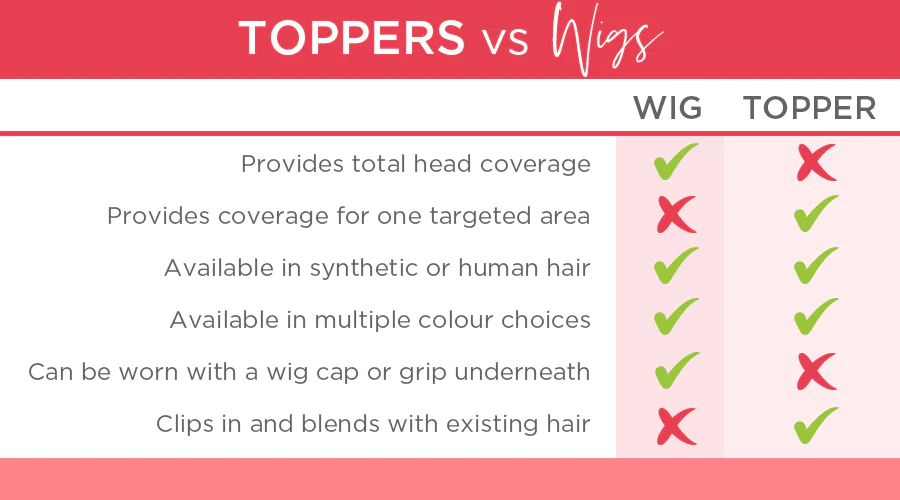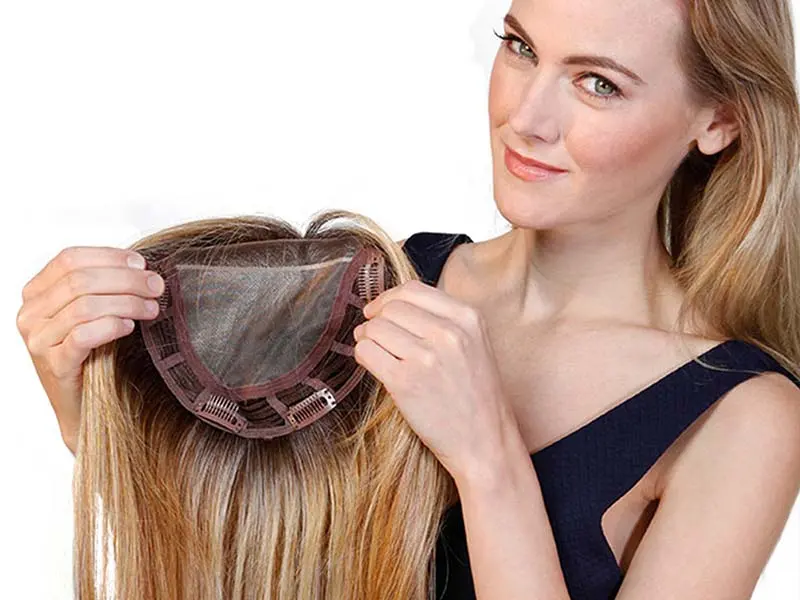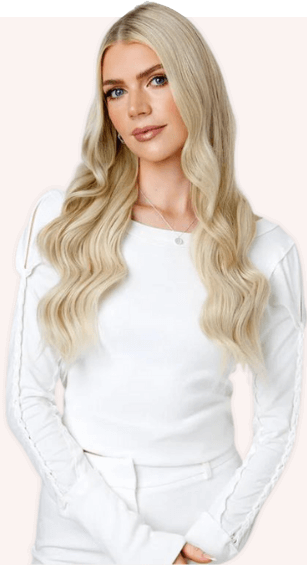When it comes to hair loss or thinning hair, finding the right solution can make all the difference in restoring confidence and enhancing your natural beauty. In today’s world, there are numerous options available to address these concerns, ranging from hair toppers to wigs. But with such a wide array of choices, how do you determine which one is best suited for you?
In this blog post, we will delve into the world of hair toppers and wigs, exploring their unique features, benefits, and considerations. Whether you’re looking to add volume, conceal thinning spots, or completely transform your hairstyle, understanding the differences between hair toppers and wigs will help you make an informed decision and choose the perfect solution.
I. Hair Toppers vs Wigs: What Are They?
Before we go to the differences between hair toppers and wigs, let’s take a look at what they are:
1. What Are Hair Toppers?

Hair toppers, also known as wiglets or top pieces, are a type of extension that mix of both hair extensions and wigs. They clip in at the top of your hair, but since they have a much smaller size compared to full wigs and provide coverage and volume to targeted areas, such as the crown or part line, they also sit flatter.
With toppers, you also get to rock your natural hair and blend it in with the topper. Similar to other forms of fake hair, you can purchase curly hair toppers, toppers with bangs, or even custom pieces with balayage to match your own style.
2. What Are Wigs?
Wigs are a versatile and widely used hair replacement solution that has been around for centuries. It’s a complete hair system that covers the entire head, providing a full head of hair. They are generally constructed on a cap or lace base, with hair strands individually hand-tied to create a realistic appearance.
Wigs offer a quick and convenient way to transform one’s hairstyle, whether for fashion purposes. Wigs are designed to mimic natural hair and come in a range of styles, lengths, colors, and textures, allowing individuals to achieve their desired look.
II. Hair Toppers vs Wigs: Advantages & Disadvantages
Hair toppers and wigs both serve as solutions for people experiencing hair loss or wanting to enhance their hair. Here are some advantages and disadvantages of each:

1. Hair Toppers:
Benefits:
- Provides targeted coverage for specific areas of hair loss.
- Blends seamlessly with natural hair.
- Offers a natural-looking solution.
- Provides customizable attachment methods for added security.
- Allows for easy maintenance and styling.
Drawbacks:
- Limited coverage for extensive hair loss.
- Requires some natural hair for blending purposes.
- May need regular adjustments for a perfect fit.
2. Hair Wigs:
Benefits:
- Offers complete coverage for extensive hair loss.
- Provides a wide range of style options.
- Suitable for individuals with different levels of hair loss.
- Can be easily styled and customized.
Drawbacks:
- Can feel hot or uncomfortable, especially in warm weather.
- Requires regular maintenance and styling.
- May take time to adjust to wearing a full wig.
III. Hair Toppers vs Wigs: What Are The Differences?
Hair toppers and wigs are both popular hairpieces used to enhance one’s appearance and address hair loss concerns. While they serve a similar purpose, there are distinct differences between the two:

Hair Toppers vs Wigs Difference #1: Coverage
Hair toppers are smaller hairpieces designed to cover specific areas of hair loss, such as thinning or bald spots on the crown, top, or front of the head. They are typically attached to the existing hair using clips, tapes, or other secure methods. On the other hand, wigs provide full coverage for the entire head, replacing all of the natural hair.
Differences #2: Construction
Hair toppers are usually constructed with a smaller base, allowing them to blend seamlessly with natural hair and provide coverage only where it is needed. They often have a monofilament or lace base, which creates the illusion of a natural scalp. Wigs, on the other hand, have larger caps that cover the entire head and are usually made with a combination of synthetic or human hair strands sewn onto a cap.
Hair Toppers vs Wigs Difference #3: Durability and Lifespan
Hair toppers are typically smaller in size and have a shorter lifespan compared to wigs. However, a high-quality hair topper can still last for several months to a year with proper care. In contrast, wigs generally have a longer lifespan – synthetic wigs can last from 3 to 5 months, while human hair wigs can last for 1 to 3 years with appropriate maintenance.
Read Now: How Long Do Wigs Last?
Differences #4: Comfort and Breathability
Hair toppers are designed to be lightweight and breathable, as they only cover a smaller portion of the head. The materials used in their base allow for better airflow to the scalp. Wigs, on the other hand, can feel heavier and less breathable due to their full coverage.
Hair Toppers vs Wigs Difference #5: Styling Options
Wigs provide more style options and are more versatile. They are simple to restyle, trim, and color to accommodate personal preferences. Wigs also allow for more variety in hair length, texture, and color. Despite having considerable style versatility, hair toppers may have some limits because of their smaller size and concentration on particular covering regions.
Differences #6: Cost
Hair toppers are typically less expensive than wigs in terms of cost. Hair toppers are a cost-effective option due to their lower size and need for less hair material, which is right for those searching for partial covering or volume improvement. Wigs, especially those made from natural human hair, can be more expensive due to the larger amount of hair used and the additional craftsmanship involved.
IV. Hair Toppers vs Wigs: Which One Is Right For You?
Selecting between a hair topper and a wig ultimately comes down to personal preference and lifestyle. Here are some things to consider:

1. What Time of Year Is Better For Your Hairpieces?
Because wigs cover more of your head and tend to have higher hair density, they are definitely hotter than hair toppers! Many women choose to wear hair toppers in the summertime and save their wigs for cooler weather.
2 .How Do You Feel About Hairpieces That Require Clips?

Hair toppers are typically fastened onto your head with clips (similar to clip-in hair extensions). Some women may find this irritating or painful, especially if they have a sensitive or oily scalp or more overall thinning hair.
If you find clips to still be painful, wigs may be a better option for you as there are more options that don’t require clipping in. Many wigs can be worn without clips and stay put with just a good fit and a wig grip!
3. What Is The Best For Thinning Hair?
Most people when starting out with early stages of hair thinning, hair loss, or alopecia opt for a hair topper because it is the easiest to blend and has the most realistic hairline. Hair toppers are best for women with hair loss who have a stronger hairline and their hair loss is concentrated at their parting and crown.
If you are at a more advanced stage of hair loss or completely bald, you will likely want to opt for a wig. Many wigs have comfort cap constructions intended for medical hair loss with softer materials and silicone linings.


 BEST SELLING PRODUCTS
BEST SELLING PRODUCTS Wig Hair
Wig Hair WHOLESALE
WHOLESALE Contact us
Contact us Sale Events
Sale Events
